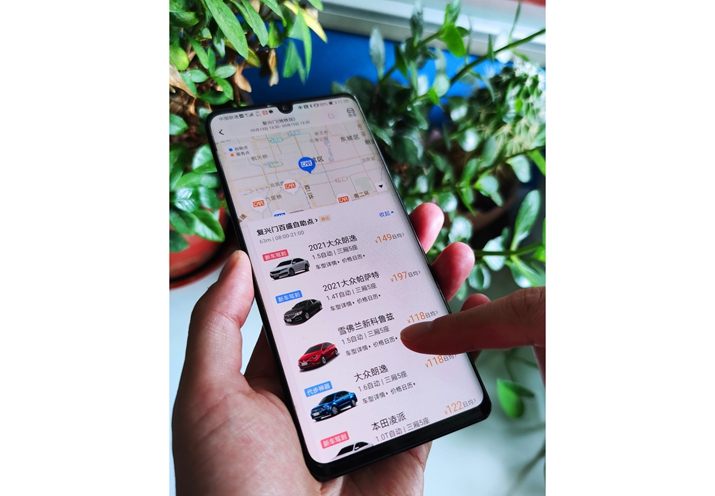|
||||||||||
| Home Nation World Business Opinion Lifestyle ChinAfrica Multimedia Columnists Documents Special Reports |
|
||||||||||
| Home Nation World Business Opinion Lifestyle ChinAfrica Multimedia Columnists Documents Special Reports |
| ChinAfrica |
| Young people transform travel market models with quickfire trips |
| Micro-tourism is spreading fast, especially among a younger generation of students and office workers |
| By Li Kaizhi VOL. 13 OCTOBER 2021 ·2021-10-26 |

Aerial photo taken on July 23 shows Yachihe Bridge of Guiyang-Qianxi highway in Guizhou Province. China’s convenient transportation network provides unlimited possibilities for micro-tourism (XINHUA)
It was a Friday afternoon in July when Zeng Xiangming, an office worker in Tianjin, had a sudden desire to travel to Beijing with friends.
They would exploit the quietening effects of the COVID-19 outbreak to visit nearby areas and escape some of the indoor boredom generated by the epidemic.
After work, Zeng caught a high-speed train to Beijing, 130 km within 30 minutes. During dinner, Zeng and his friend decided on the destination for the next day's trip: Hengshan Mountain in Shanxi Province, 350 km away from Beijing. Then he rented a car and bought insurance through the car rental app on his phone.
"In the past, you had to decide lots of things before traveling," Zeng said. "Now, just following your heart will be a popular travel trend."
Diverse travel needs
For most Chinese, travel used to mean a family journey to a distant place for a few days. But now a short weekend can be a holiday trip, especially for young people with a flair for speedy decision-making. They take the savvy efficiency of online working and deploy their skill set in other facets of life, notably travel.
This emerging tourism model, which is characterized by short and near-spontaneous trips people can set off anytime and anywhere, has been dubbed as micro-tourism.
A key difference with traditional tourism is that micro-tourism does not require long distance or detailed planning. Tourists seize time to follow their hearts.
Wang Jingqiang, Director of the Tourism Experimental Center of Huaqiao University in Fujian Province, lists more characteristics of this nascent mode: diverse people with diverse tourism interests; no clear boundary in the choice of destination from urban relaxation to rural experiences; convenient transportation with travel time-saving advantages; and subsidies targeted at nearby residents such as ticket discounts or extended opening times.
There are more and more people like Zeng in the big cities who are taking their brief time windows to have leisure nearby, whether by self-drive or by convenient transportation. They need little preparation, simple registration procedures and short itineraries.
Reasons behind
Micro-tourism is spreading fast, especially among a younger generation of students and office workers.
"With the steady development of the economy and the continuous improvement of social productivity, people's living conditions are becoming more affluent and their leisure consciousness is gradually awakening to the development of micro-tourism," Wang said.
To meet their needs, scenic spots must provide online access and a more individual touch: More than 6,000 A-class tourist attractions in China offered online reservation services as of August, according to the Ministry of Culture and Tourism. All 5A scenic spots except open venues have reservation systems with time slots. State-owned tourist attractions will all realize online reservation booking by the end of this year.
"I still remember when I used a three-day holiday in May 2019 to climb Huashan Mountain in Shaanxi Province with my friends," Zeng said. "We woke up at 4:30 a.m. and arrived at the entrance of the scenic spot at 6 a.m.
"There was almost no one on the scenic spot footpath. People could climb the mountain at any time."
Micro-tourists often decide about their destinations by perusing online and en route data: road congestion, weather, transport hubs, car rental system and the total number of tourists browsing.
Another important reason for the birth and accelerated growth of micro-tourism has also been the pandemic, which makes most long-distance travel impossible. An inevitable result was for regional tourism suppliers to target short-distance travel.

Interface of a Chinese car-renting app (HU FAN)
Future trends
The Beijing Municipal Bureau of Culture and Tourism held a micro-tourism activity on August 25 to promote excellence through collecting, collating and selecting micro-travel routes and options.
With a raft of restrictions on traditional cross-province and group tours, the micro-tourism options surrounding the city – close, short and easy travel – are increasingly favored during weekends and long holidays.
Zhang Jing, Director of Resources Development Division of Beijing Municipal Bureau of Culture and Tourism said the bureau hoped the event would uncover new cultural and travel resources in Beijing like cultural venues, reading spaces or new consumption scenes.
He said these options could then be integrated into micro-tourism routes which can be easily reached, deeply experienced, fashionable in consumption and novel in scenes, and release and promote them to society centrally, so that everyone can discover the beauty of the city, the beauty of the surroundings, the beauty of life, feel a different kind of refinement and beauty in the familiar Beijing city, and also let the people constantly enhance their sense of achievement in the city.
In addition to Beijing, other places have also done enough preparations for micro-tourism for tourists.
Wujin District in Changzhou, Jiangsu Province, is a city with a history of more than 2,700 years.
Xue Xin, Deputy Director of the district's Culture, Radio, Television, Tourism and Sports Bureau, said Wujin was planning to create the first domestic tourist area based on culture around China's Spring and Autumn period (770–476 B.C.). Targeting the preferences of younger visitors, the bureau is creating a cartoon culture theme park involving animated games.
According to Xue, the district is also helping fund an industrial adjustment and transition among travel agencies, homestays and hotels during the epidemic, adding more than 6,000 parking spaces. A big data platform and apps support smart service systems like mobile phone booking, explanation and complaints.
Zeng and his friend finished their trip. After receiving his friend's safe arrival message in Beijing, Zeng replied with a happy face emoji. The reply was a happy reflection on a happy trip and also a hope for the next micro-trip.
(Print Edition Title: Rising Scale)
Comments to likzh@chinafrica.cn
| About Us | Contact Us | Advertise with Us | Subscribe |
| Copyright Beijing Review All rights reserved 京ICP备08005356号-5 京公网安备110102005860号 |